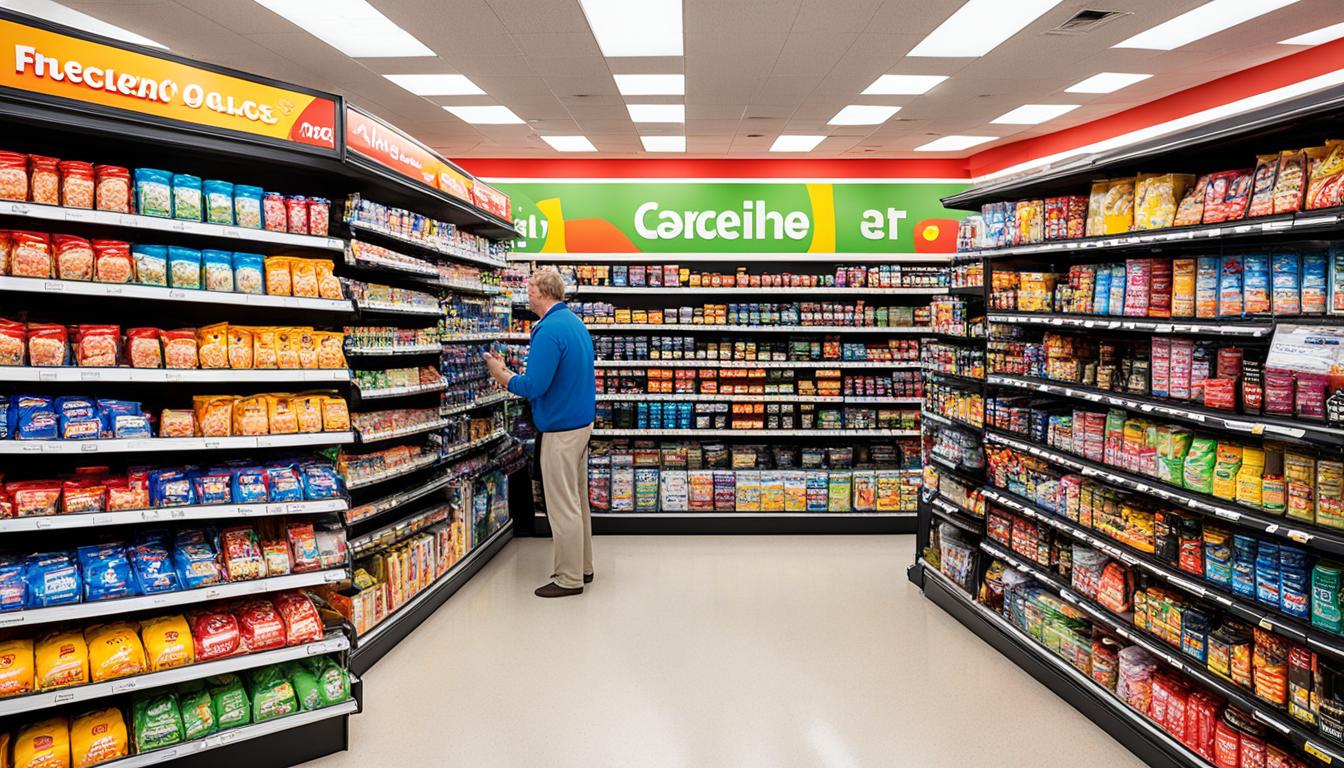In-store marketing is a crucial aspect of retail marketing strategies. It takes place in brick-and-mortar stores and focuses on engaging with customers and providing a personalized experience during their shopping session. Unlike digital marketing, in-store marketing allows for real-time interactions with customers, increasing the chances of making a sale. It is important for brands to invest in effective in-store marketing campaigns to increase market share, create a memorable shopping experience, and drive sales.
In-store marketing encompasses a variety of tactics, such as in-store promotions, retail advertising tactics, and store display techniques, to engage with customers and promote products effectively. With the right strategies in place, brands can capture customers’ attention, influence purchasing decisions, and create a strong brand presence at the point of sale.
Key Takeaways:
- In-store marketing focuses on engaging with customers and providing a personalized shopping experience.
- It allows for real-time interactions with customers, increasing the chances of making a sale.
- In-store marketing tactics include in-store promotions, retail advertising tactics, and store display techniques.
- Effective in-store marketing strategies can increase market share, create memorable shopping experiences, and drive sales.
- Investing in in-store marketing is essential for brands looking to differentiate themselves and succeed in the competitive retail landscape.
The Benefits of In-Store Marketing
In-store marketing offers a multitude of benefits for brick-and-mortar stores. By engaging with customers directly at the point of sale, in-store marketing provides a personalized experience that can significantly enhance customer engagement and satisfaction, leading to increased loyalty. This form of marketing also has the power to capture customers’ attention and influence their purchasing decisions, ultimately driving revenue growth.
One of the significant advantages of in-store marketing is its ability to create memorable shopping experiences that set brands apart from their competitors. By integrating products with experiences, brands can create a unique and personalized environment for their customers, fostering a deep connection and emotional attachment to the brand.
Direct Customer Engagement and Personalized Experience
At the core of in-store marketing is the opportunity for direct customer engagement. Unlike online marketing, which relies on virtual interactions, in-store marketing allows brands to interact with customers in real-time, offering personalized recommendations, answering questions, and catering to their specific needs. This level of personalization not only enhances the overall shopping experience but also establishes a sense of trust and loyalty between the brand and the customer.
Increased Revenue through Influencing Purchasing Decisions
In-store marketing has a significant impact on influencing customers’ purchasing decisions. By strategically placing products, creating eye-catching displays, and implementing effective promotional tactics, brands can capture customers’ attention and guide them towards making a purchase. The ability to physically interact with products and experience them firsthand further reinforces customers’ confidence in their buying decisions, resulting in increased sales and revenue for brick-and-mortar stores.
In conclusion, in-store marketing provides several invaluable benefits for brick-and-mortar stores. It enables direct customer engagement, fosters personalized experiences, and significantly influences purchasing decisions. By investing in effective in-store marketing campaigns, brands can create memorable shopping experiences that enhance customer satisfaction, loyalty, and ultimately increase revenue.
Types of In-Store Marketing Tactics
In-store marketing employs various tactics to effectively engage customers and promote products. These tactics work together to create a cohesive in-store marketing strategy that drives sales and enhances the customer experience.
1. Display Compliance
Display compliance ensures that products are properly displayed and organized on shelves. By maintaining a visually appealing and organized display, brands can capture customers’ attention and encourage them to make purchases. Display compliance includes proper product positioning, facing, and arrangement.
2. Shelf Labelling
Shelf labelling is essential for providing clear pricing and product information to customers. Accurate and easily visible shelf labels enable customers to make informed purchasing decisions and compare prices. Brands can also use shelf labelling to highlight promotions and special offers, attracting customers and facilitating sales.
3. Inventory Management
Inventory management plays a crucial role in successful in-store marketing. By ensuring adequate stock levels, brands can prevent out-of-stock situations, maintain customer satisfaction, and maximize sales opportunities. Effective inventory management involves real-time tracking, replenishment strategies, and demand forecasting.
4. Pricing Strategies
Pricing strategies are an integral part of in-store marketing tactics. Brands can employ various pricing strategies, such as discounts, bundling, and loyalty programs, to attract customers and increase sales. Well-executed pricing strategies can create a sense of value and urgency, encouraging customers to make purchases.
To implement a comprehensive in-store marketing strategy, brands should consider utilizing display compliance, shelf labelling, inventory management, and pricing strategies. By combining these tactics, brands can optimize the customer experience, drive sales, and foster long-term customer loyalty.
Creating an Engaging Shopper Experience
In-store marketing plays a crucial role in shaping the shopper experience. It goes beyond traditional advertising to create immersive and interactive campaigns that captivate customers and make their time in-store memorable. By utilizing various techniques, such as interactive displays and sensory elements, brands can engage shoppers on multiple levels, appealing to their senses and creating a lasting impression.
One effective strategy is the use of interactive displays. These displays allow customers to actively engage with products and information, fostering a sense of exploration and involvement. By incorporating touchscreens, motion sensors, and augmented reality, brands can provide an interactive experience that encourages shoppers to spend more time in-store and discover the unique features and benefits of their products.
Sensory elements play a significant role in enhancing the shopper experience. Retailers can leverage the power of sight, sound, touch, and smell to create a multi-dimensional environment that evokes emotions and connects with customers on a deeper level. For example, strategically placed lighting and audio cues can create an ambiance that aligns with the brand image, while the use of textures and scents can further enhance the sensory experience.
Brands that prioritize creating an engaging shopper experience through in-store marketing campaigns can differentiate themselves in a crowded marketplace. By designing immersive and interactive experiences that appeal to the senses, brands can forge a connection with customers and leave a lasting impression. This not only increases the likelihood of purchase during the current shopping trip but also encourages repeat visits and builds long-term brand loyalty.
| In-Store Marketing Techniques | Benefits |
|---|---|
| Interactive displays | Engages customers and fosters exploration |
| Sensory elements | Creates a memorable and immersive experience |
| Multi-dimensional environment | Elicits emotional responses and fosters connections |
Exploration of Shopping Incentives
Tax-free shopping can be one such innovative practice, among others, that integrates into various retail strategies. The concept stands parallel to immersive in-store tactics such as interactive displays and digitally-enhanced experiences. Understanding common methods for Tax Free shopping provides insights into how retailers offer value-driven options to global shoppers. Such strategies learn from broader marketing efforts aiming for personalization and unique consumer experiences.
The Role of Retail Branding in In-Store Marketing
Retail branding plays a significant role in driving the success of in-store marketing campaigns. It encompasses various elements such as brand identity, brand positioning, and brand messaging that contribute to creating a strong and distinctive presence for a brand within a retail environment.
Establishing a compelling brand identity is essential in in-store marketing as it helps differentiate a brand from its competitors. A well-defined brand identity consists of a brand’s visual elements, personality, values, and mission, all of which contribute to shaping the overall perception of the brand.
Brand positioning is another crucial aspect of retail branding. It involves strategically positioning a brand in the market to emphasize its unique value proposition and appeal to the target audience. Effective brand positioning helps customers understand why they should choose a particular brand over others.
Consistent brand messaging
A consistent brand messaging strategy is vital in in-store marketing to ensure clear and compelling communication with customers. It involves developing a cohesive message that aligns with the brand’s values, resonates with the target audience, and reinforces the brand positioning. Consistent messaging across all in-store touchpoints, including packaging, displays, and signage, helps create a unified and memorable brand experience for customers.
By prioritizing retail branding in their in-store marketing efforts, brands can create a strong and differentiated presence that builds customer trust and loyalty. A well-executed retail branding strategy enhances the overall shopping experience, influences purchasing decisions, and ultimately drives sales.
When done effectively, retail branding in in-store marketing goes beyond attracting customers solely based on pricing or product features. It creates an emotional connection with customers, making them feel a sense of familiarity, trust, and loyalty towards the brand. This emotional connection is what sets a brand apart in today’s competitive retail landscape.
Table: Examples of Successful Retail Branding Initiatives in In-Store Marketing
| Brand | Initiative | Impact |
|---|---|---|
| Apple | Consistent minimalist store design and packaging | Reinforced brand’s sleek and innovative image, enhanced customer experience |
| Nike | Immersive in-store experiences and interactive displays | Engaged customers, strengthened brand loyalty |
| Starbucks | Consistent use of brand colors, logo, and store ambiance | Builds a sense of familiarity, encourages repeat visits |
Examples of Successful In-Store Marketing Campaigns
Successful in-store marketing campaigns can take various forms, including brand activations, product promotions, and eye-catching display signage. These campaigns are designed to capture the attention of customers and create memorable experiences that drive sales and strengthen brand awareness.
One example of a successful in-store marketing campaign is the collaboration between Nike and Apple. By leveraging their respective brand strengths, Nike and Apple created an interactive experience in select Nike stores where customers could try on Nike shoes and test them out on a treadmill while using the Nike+ app on an Apple device. This brand activation not only showcased the functionality of Nike shoes but also highlighted the seamless integration between Nike and Apple products.
Another example is Coca-Cola’s product promotion campaign during the holiday season. Coca-Cola placed festive-themed displays near checkout counters, featuring their iconic polar bear mascot and limited-edition holiday packaging. By creating visually appealing displays and offering exclusive holiday promotions, Coca-Cola successfully attracted customers and increased sales during the holiday shopping season.
Eye-catching display signage is also an effective in-store marketing tactic. Home Depot, for instance, uses vibrant and informative signage throughout their stores to guide customers to different departments, highlight current promotions, and provide DIY tips and inspiration. By combining clear messaging with visually appealing graphics, Home Depot engages customers and enhances their overall shopping experience.
Successful In-Store Marketing Campaign Examples:
| Brand | Campaign | Objective |
|---|---|---|
| Nike + Apple | Interactive Experience | Showcasing product functionality and brand integration |
| Coca-Cola | Holiday Promotion | Increase sales during the holiday season |
| Home Depot | Informative Signage | Enhancing the customer shopping experience |
By implementing successful in-store marketing campaigns, brands can drive foot traffic, increase sales, and enhance brand awareness. These examples demonstrate the power of brand activations, product promotions, and display signage in creating engaging experiences that leave a lasting impression on customers.
The Importance of Display Compliance in In-Store Marketing
Display compliance plays a crucial role in the success of in-store marketing. It ensures that products are properly displayed, visible to customers, and aligned with the overall merchandising plan. By adhering to planograms and ensuring display compliance, brands can optimize product visibility, improve the shopper experience, and ultimately increase the likelihood of sales.
Effective display compliance involves consistently monitoring and adjusting displays to ensure they are visually appealing, organized, and fully stocked. When products are displayed in an organized and eye-catching manner, it captures the attention of shoppers and encourages them to explore the offerings further. This can lead to impulse purchases and increased sales.
Furthermore, display compliance enhances the shopper experience by making it easier for customers to find what they are looking for. When products are displayed in their designated locations and are clearly visible, it eliminates confusion and frustration, improving overall customer satisfaction.
For example, having a properly stocked and well-arranged section of a grocery store dedicated to organic produce can improve product visibility and make it more convenient for health-conscious shoppers to find the items they need. This not only enhances the shopper experience but also strengthens the store’s reputation as a reliable source for organic products.
Display compliance also ensures planogram adherence, which refers to following a specific layout or arrangement of products on the shelves. This consistency creates a sense of familiarity for returning customers, making their shopping experience more efficient. It also allows brands to strategically position products for maximum exposure to target customers.
| Benefits of Display Compliance in In-Store Marketing |
|---|
| 1. Optimize product visibility |
| 2. Improve shopper experience |
| 3. Increase sales and revenue |
| 4. Enhance brand reputation and loyalty |
The Role of Technology in In-Store Marketing
Technology has revolutionized the way brands approach in-store marketing, enabling them to create immersive and personalized experiences for customers. By leveraging various technological tools and platforms, brands can effectively engage shoppers and drive sales. Here are some key technologies that play a significant role in enhancing in-store marketing strategies:
Digital Signage
Digital signage offers an interactive and visually appealing way to deliver targeted messages and promotions to customers. Brands can utilize dynamic and customizable displays to capture customers’ attention, highlight product features, and create a sense of urgency. This technology allows for real-time updates, ensuring that the content remains relevant and engaging.
Mobile Apps
Mobile apps have become an integral part of the in-store shopping experience. Brands can develop mobile apps that provide personalized recommendations based on customer preferences, offer exclusive discounts and rewards, and facilitate seamless checkout processes. By leveraging the power of mobile technology, brands can enhance customer loyalty and create a seamless omnichannel experience.
Augmented Reality
Augmented reality (AR) has gained traction in the retail industry, allowing brands to integrate virtual elements into the physical environment. By using AR in in-store displays, customers can interact with virtual products, try them on virtually, and make informed purchase decisions. This immersive technology enhances engagement, encourages exploration, and creates memorable shopping experiences.
By embracing technology, brands can elevate their in-store marketing efforts and stay ahead of the competition. Digital signage, mobile apps, and augmented reality provide unique opportunities to engage customers, deliver targeted messages, and create personalized experiences that drive sales and foster brand loyalty.
Measuring the Effectiveness of In-Store Marketing
Measuring the effectiveness of in-store marketing campaigns is essential for optimizing strategies and improving overall performance. By analyzing sales data and gathering valuable insights through customer surveys, brands can make data-driven decisions to enhance their in-store marketing efforts.
1. Sales Data Analysis
One way to measure the effectiveness of in-store marketing is through thorough sales data analysis. By examining sales figures and trends, brands can gain valuable insights on the impact of their in-store marketing campaigns on revenue. This analysis helps identify the effectiveness of specific tactics, such as promotional displays or pricing strategies, and determine their contribution to overall sales performance.
2. Customer Surveys and Feedback
Customer surveys and feedback play a vital role in measuring the effectiveness of in-store marketing efforts. By collecting feedback directly from customers, brands can gain valuable insights into the customer experience and identify areas for improvement. Surveys can help assess the impact of in-store marketing on customer satisfaction, brand perception, and purchase decisions. This information provides a holistic understanding of the effectiveness of in-store marketing tactics.
By combining quantitative data from sales analysis with qualitative data from customer surveys, brands can gain a comprehensive view of the effectiveness of their in-store marketing initiatives. This integrated approach allows for well-informed decision-making and optimization of future strategies.
Implementing these measurement practices enables brands to continuously evaluate the success of their in-store marketing campaigns, make data-backed improvements, and ultimately drive sales and customer engagement.
In-Store Marketing vs. Online Marketing
In-store marketing and online marketing are both essential components of a successful omnichannel marketing strategy. While online marketing offers targeted and measurable campaigns, in-store marketing provides the opportunity for real-time customer engagement and personalized experiences. By leveraging the strengths of each channel and creating a seamless and cohesive customer journey, brands can maximize customer engagement, drive sales, and build brand loyalty.
Online marketing allows brands to reach a wide audience through various digital channels such as social media, search engine optimization, and email marketing. It offers the advantage of precise targeting and personalized messaging based on customer data and preferences. Marketers can track and measure the performance of online campaigns, gaining valuable insights to optimize strategies and improve results.
On the other hand, in-store marketing enables brands to connect with customers in a physical environment, providing a sensory experience that engages all five senses. It allows for face-to-face interactions, personalized recommendations, and immediate feedback. In-store marketing strategies can include interactive displays, product demonstrations, and experiential activations that leave a lasting impression on customers.
Benefits of In-Store Marketing:
- Real-time Customer Engagement: In-store marketing allows brands to engage with customers in real-time, providing personalized assistance and building relationships.
- Memorable Experiences: In-store marketing creates memorable shopping experiences through sensory elements, interactive displays, and unique activations.
- Emotional Connection: In-store marketing connects with customers on an emotional level, eliciting positive emotions and building brand loyalty.
- Immediate Gratification: In-store marketing provides instant gratification through immediate access to products, eliminating the need for shipping or waiting.
Benefits of Online Marketing:
- Precise Targeting: Online marketing allows for precise targeting based on customer data, demographics, and online behavior.
- Measurable Results: Online marketing provides measurable data and analytics, enabling marketers to track and optimize campaign performance.
- Cost-Effective: Online marketing can be more cost-effective than traditional advertising methods, offering a higher return on investment.
- Global Reach: Online marketing transcends geographical boundaries, allowing brands to reach a global audience and expand their market reach.
To achieve the maximum impact and capitalization on both in-store and online opportunities, brands should adopt an omnichannel marketing approach. This involves integrating all marketing channels seamlessly, ensuring consistent messaging and brand experience across all touchpoints. By leveraging the strengths of both in-store and online marketing, brands can enhance customer engagement, drive conversions, and ultimately achieve marketing success.
Best Practices for Effective In-Store Marketing
When it comes to in-store marketing, adopting best practices is key to achieving success. By implementing clear messaging, strong visual branding, and comprehensive employee training, brands can create a compelling shopping experience that resonates with customers and drives sales.
Clear Messaging
One of the essential best practices for in-store marketing is to ensure clear and concise messaging. Customers should easily understand the value proposition of products and promotions, making it crucial to communicate benefits and key information effectively. By using language that is succinct and customer-centric, brands can capture attention and drive engagement.
Strong Visual Branding
A strong visual brand identity is vital for in-store marketing. Consistent branding throughout the store creates a memorable and cohesive experience for customers. From signage and displays to packaging and product placement, every touchpoint should reflect the brand’s visual identity. This helps to reinforce brand recognition, build trust, and differentiate from competitors.
Employee Training
Well-trained employees play a pivotal role in delivering exceptional in-store experiences. Brands should invest in comprehensive training programs to equip frontline staff with the knowledge and skills needed to provide excellent customer service. This includes effectively communicating with customers, providing accurate product information, and addressing any inquiries or concerns. By ensuring that employees are knowledgeable and customer-focused, brands can enhance the overall shopping experience and build strong customer relationships.
By following these best practices for in-store marketing – clear messaging, strong visual branding, and employee training – brands can create a compelling and engaging shopping environment that captures customer attention, drives sales, and fosters brand loyalty.
Conclusion
In-store marketing is a powerful tool for retailers looking to achieve retail success. By implementing effective strategies and leveraging technology, brands can engage customers, drive sales, and create unforgettable shopping experiences. Prioritizing display compliance ensures that products are properly showcased and increases the likelihood of making a sale. Measuring the effectiveness of campaigns and continuously improving them is essential for long-term success.
Successful in-store marketing takeaways include understanding the importance of customer engagement and personalized experiences. By creating memorable interactions with shoppers, brands can build loyalty and differentiate themselves in the competitive retail landscape. Utilizing technology such as digital signage and mobile apps can enhance customer experiences and increase sales.
In conclusion, retailers should invest in in-store marketing to stand out in the market and achieve retail success. By combining effective strategies, display compliance, and technology, brands can create a unique shopping experience that captivates customers and drives sales. Continuous improvement and measurement of in-store marketing efforts are crucial for long-term success in the dynamic retail industry.




